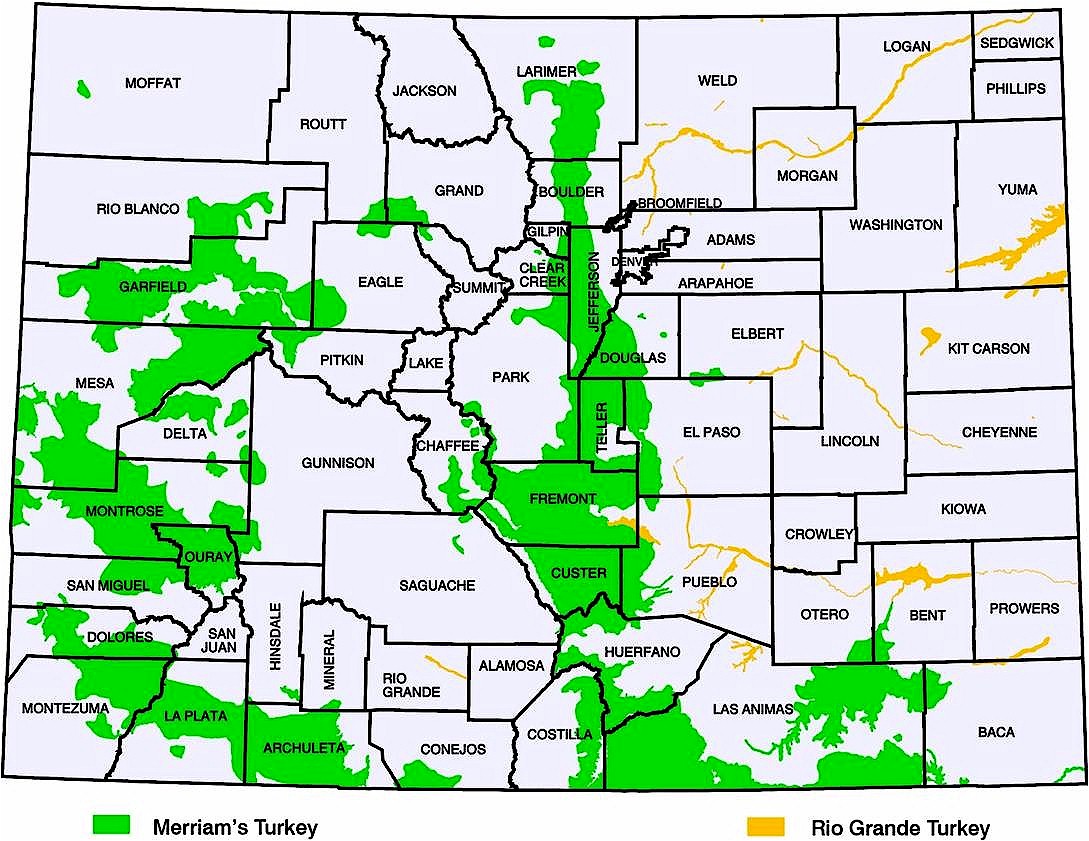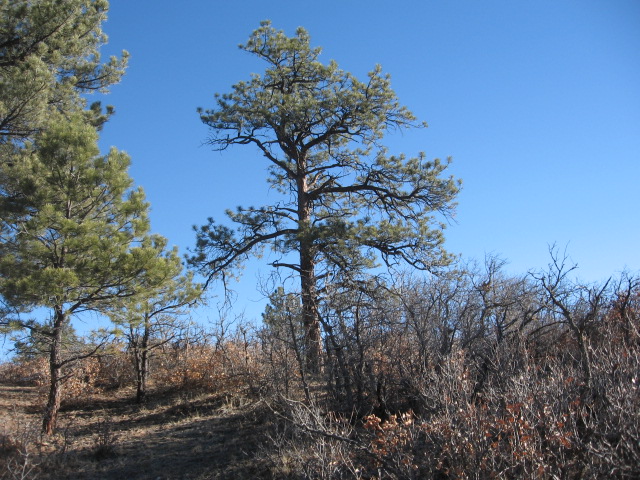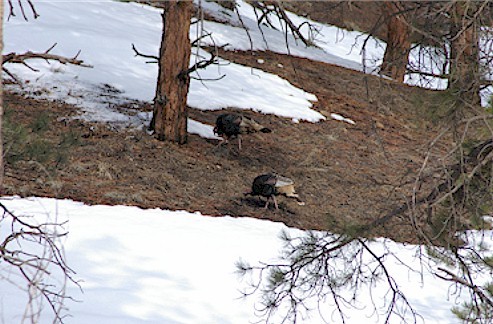Scouting - A Big Part of the Game
By Jim Bulger, Hunter Outreach Program Coordinator
A major part of the spring game is learning how to find the birds in the first place. Yes, calling skills, woodsmanship and your ability to shoot accurately with your firearm or bow is going to become very important but first you have to find the birds. Let’s break scouting into some smaller bites and talk about them in a bit of detail as we begin to understand this concept of finding birds and scouting techniques.
Finding a Merriam’s TurkeyMuch of what is written or shown in video lessons about turkey hunting is focused on the Eastern subspecies. I did a search online for articles specifically about Merriam’s and found a few short articles about them but not much detail. Colorado is home to two subspecies of turkey, the Rio Grande and the Merriam’s. Both subspecies have some specific habitat they prefer and thus require some specific scouting methods. Developing a hunt plan for a specific bird takes a bit of understanding each species. |
 The Merriam’s subspecies is native to Colorado and can be found predominately in the foothills and mountainous areas west of I-25. Along the foothills east of the Continental Divide, you will often find hybrid birds, a mix of Merriam’s and Rio Grande.
The Merriam’s subspecies is native to Colorado and can be found predominately in the foothills and mountainous areas west of I-25. Along the foothills east of the Continental Divide, you will often find hybrid birds, a mix of Merriam’s and Rio Grande.
Merriam’s can cover a great deal of ground during the week looking for new sources of favorite foods but some habitat provides the corner grocery store for them and this is where you should concentrate your scouting efforts.
Merriam’s prefer to roost in large Cottonwood or Ponderosa Pine stands. The limbs of the trees need to be open enough for the birds to fly up and not get hung up in the trees; they must have enough visibility to see the ground as well. Forbes and shrubs nearby make for good food sources. Grass openings and forest trails provide strut zones and those tasty grasshoppers and other bugs.
 During the spring mating season, Merriam’s will tend to feed and roost near the same areas where the hen are laying eggs, so their daily movements will not be nearly as great while breeding and nesting season is underway as in the fall and winter when the search for food is on the top of the daily “to do” list.
During the spring mating season, Merriam’s will tend to feed and roost near the same areas where the hen are laying eggs, so their daily movements will not be nearly as great while breeding and nesting season is underway as in the fall and winter when the search for food is on the top of the daily “to do” list.
The picture at the right shows a typical roost tree for a Merriam’s turkey. Note the open limbs of the Ponderosa and the ridge running behind the trees. The birds will use the ridge above the trees as a landing and launching pad to fly up to roost, usually associated with an open area near the roost trees. Finding trees just below the top of a ridge is a good place to start looking for roosts in Merriam’s country.
Where to look in a big stateThe range map shows the vast area a hunter needs to consider when planning to scout for birds. If you compare the range shown in green for Merriam’s with the dark yellow shown for Rio Grande’s, it becomes clear that using a good topographic map to narrow your scouting efforts is paramount in chasing the mountain birds. The range shown for Merriam’s is just that, their native range. It does not mean there are large flocks of birds in every corner of the green area of the map. It means that birds are generally found in those regions of the state. And, with such a large native range, the question of “How do I find them?” is generally the most frequently asked one. A few tips on narrowing your search may help you out a bit. Take your map and consider a few factors in finding birds: |
How far do you want to drive from home? If you are looking to day hunt, that is probably no more than two hours one way.
Inside my desired driving range, is there good habitat for the birds to roost, feed and nest?
Can I find accessible public lands that have good habitat and not much human pressure?
How hard do I want to work to harvest a turkey? This question is the money question as the typical Merriam’s hunter will cover a lot of ground on his or her feet and vehicle, changing elevations, making lots of stops but seeing some awesome scenery along the way.
Another look at the range map above shows the diversity of the Merriam’s native range. Most of the range falls into the unlimited license category in Colorado so the avid turkey hunter can plan his approximately six week turkey season using some at home research, applying your understanding of turkey habits and a bit of Biology 101. If you are lucky enough to draw a limited license in the spring limited draw, you can harvest (at least chase) two bearded birds in the spring. Even if you can only hunt an unlimited license, learning to find Merriam’s in the vast expanse of their habitat will help you in your quest to become a better turkey hunter.
The map also shows the Merriam’s range along the foothills and higher mountain areas on the east side of the Continental Divide, then pick up again in Western and Southwestern Colorado. Understanding the altitude of the home range plays a role in your scouting and hunting plans. The birds will move from the lower elevations of the foothills to higher elevations looking for new forbs and insects as the snow retreats up the mountain and new growth begins. Generally, this tends to be about the last week of April into May. That timeframe is when the turkey hunting in the foothills tends to heat up, as the birds begin breeding season in earnest.
Once you have done some investigation and a bit of soul searching, lay out a good topo map of your chosen areas and look for likely habitat clues to hold birds. Look for forest roads, small parks that will hold meadows of new forbs and insects, look for some pointed ridges which drop into active streams or small ponds. Circle those locations and develop a scouting plan. Grab your map, get a picnic basket, maybe a bottle of wine, (binos and crow call go in the bottom of the picnic basket) and a blanket; tell your spouse or best girl you are taking her on a picnic and head out to put boots on the ground in your marked locations. (Note: this works only a few times before you get caught at the plan, but I taught my wife to love turkey hunting and now the trips are fun for both of us). Boots on the ground does not mean you have to walk to every location but at some point you do have to walk.
On the way to your scouting areas, stop at the local gas station, eatery or sporting goods store and ask if anyone has seen turkeys. It is not time to be shy about what you are looking for and you will be surprised at how many folks will be glad to tell you about a flock they have seen while driving to work or that a friend has some turkeys on his property that are driving him nuts with incessant gobbling.
Stop and talk to the local wildlife officer, waste management driver, FEDEX or UPS driver and the postman is always a good bet. Why? These folks are driving the roads at all hours of the day and you can save a great deal of time, gas and miles if you just start asking everyone about turkeys.
Boots on the GroundOnce you have a few local tips or narrowed your search to some areas to investigate, pull out your CSI kit (binos, backpack and woodsmanship skills) and start putting boots on the ground. As you walk the forest roads, two-tracks or trails in your scouting area, look for tracks, droppings, feathers. Look in the dry roadbed for strut marks, tracks and feathers, indicating a potential strut zone for a lonely tom. Look at the emerging forbs and grasses in the meadows, perhaps some dry areas on the fringe of a meadow where potential dusting areas (denoted by a shallow depression or bowl of sandy dry soil with feathers and a lot of tracks converge) and look for roost trees, potential nesting cover for the hens and finally, maybe just maybe, see a turkey or two hanging out in the general vicinity.  Look at all the “evidence”, consider what you have seen or collected and decide if this place you have scouting has potential. If there is no evidence, probably time to head to the next place. If this place has some potential, pull out that picnic basket and head for a ridge with some good visibility and glass for a while. While glassing, use good technique and glass slowly, glass each area three times before you look to the next section of your search. Remember you are looking for movement or shapes, something dark that should not be there. Think about looking for a black beetle in the grass in your backyard; that is what a turkey looks like at 1000 yards through binoculars. Look at all the “evidence”, consider what you have seen or collected and decide if this place you have scouting has potential. If there is no evidence, probably time to head to the next place. If this place has some potential, pull out that picnic basket and head for a ridge with some good visibility and glass for a while. While glassing, use good technique and glass slowly, glass each area three times before you look to the next section of your search. Remember you are looking for movement or shapes, something dark that should not be there. Think about looking for a black beetle in the grass in your backyard; that is what a turkey looks like at 1000 yards through binoculars. If the “picnic” has gone well, you may be able to stay in the woods till the sun sets (tell her you want to enjoy a beautiful sunset with her) and hear toms gobbling heading to the roost. Try using a locator call (crow call, coyote call or even a small air horn) to urge a tom into responding with a shock gobble. I stay away from using actual turkey calls while scouting or roosting birds but others will tell you there is nothing wrong with it. Each hunter has to develop his own style and techniques. If you can get a response, mark that location on your map and plan to return to the area during the season to see if the birds are still in the general vicinity. When attempting to locate Merriam’s, you will probably repeat the scenario above many times. Once in a while, you get lucky and find a good place on the first or second try but that is rare. Look back at question 4 in the article and decide how hard you want to work for that bird. Stay with it and you will find birds or give it up and go fishing. |
This article provided a glimpse of the scouting techniques for Merriams. Read books, online articles and watch videos about these birds, not only the hunting videos but those about the biology, habits and habitat. Talk to other turkey hunters about how they scout and what they look for when choosing an area. Think about becoming a Turkey CSI. Wonder if that would be a good television series? In the next article, we will focus on the Rio Grande in Colorado. Many of the tips and techniques we discussed above will apply to the Rio, but the terrain and scouting techniques are a bit different.

